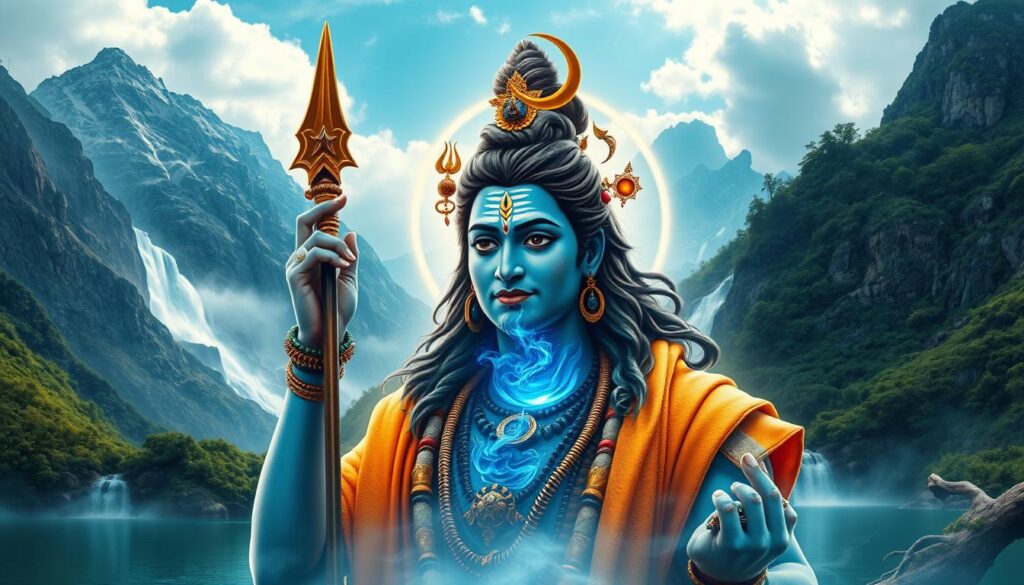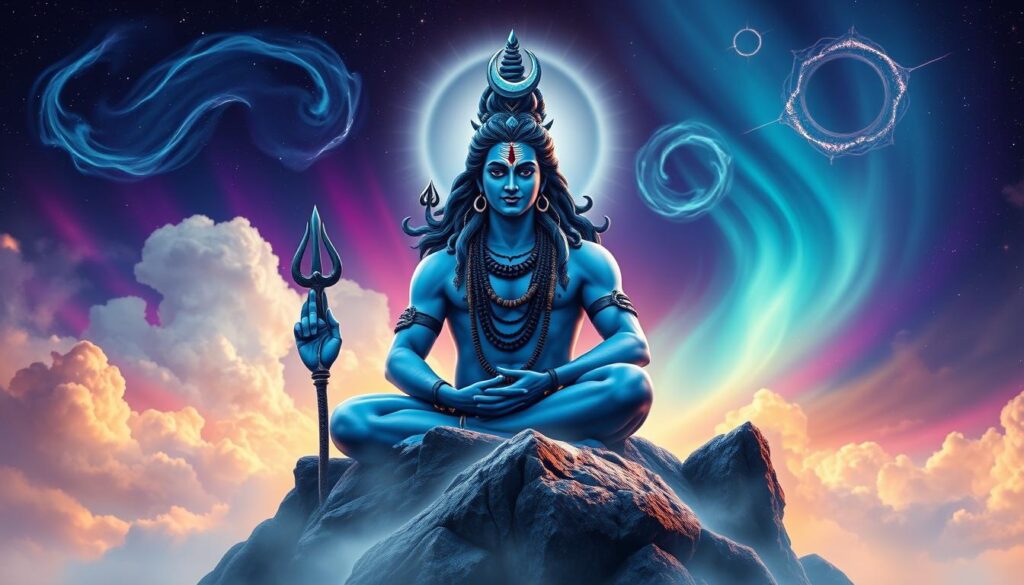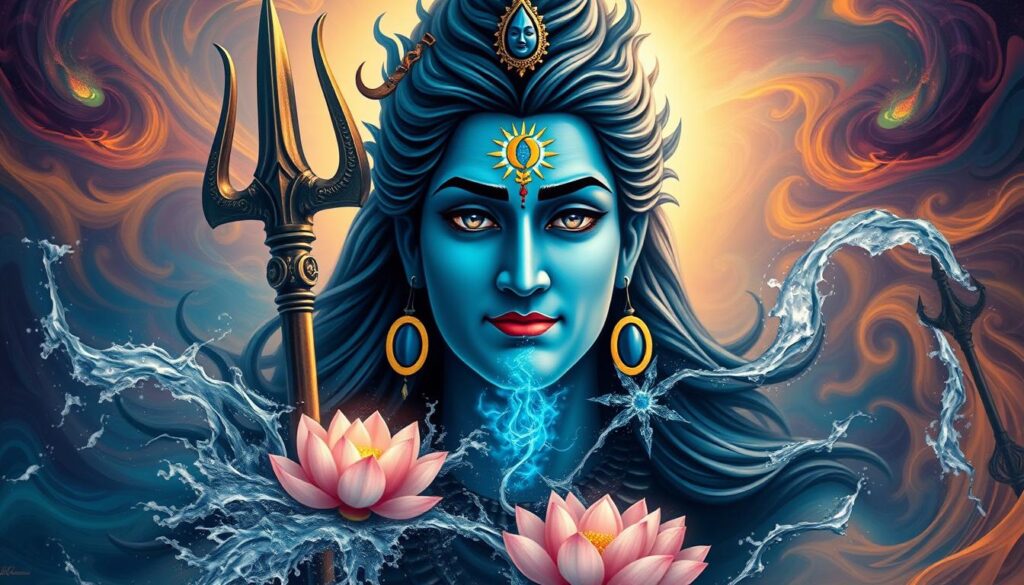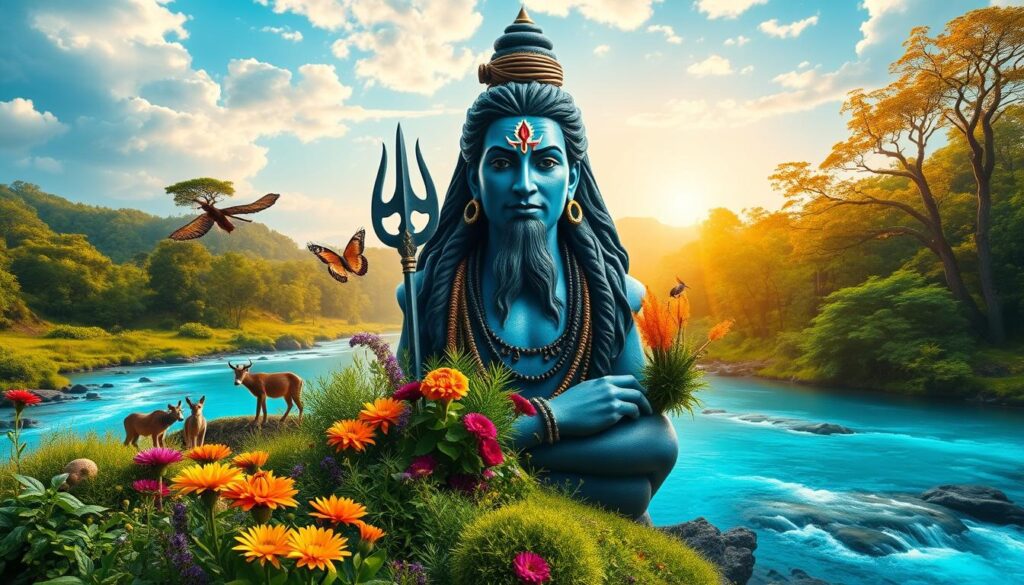Lord Shiva is famous for his matted hair and snake around his neck. He also has a third eye on his forehead. His blue throat is one of his most striking features, earning him the name Neelkanth.
His blue throat comes from drinking poison during the Samudra-Manthan event. It shows he can handle insults and give blessings at the same time.
The story of Neelkanth is a big part of Hindu mythology. It shows why Lord Shiva is seen as a protector and savior. By learning about Neelkanth, people can understand how to deal with negativity and grow spiritually.
The Significance of the Name Neelkanth
The name Neelkanth comes from Sanskrit. “Neela” means blue and “kantha” means throat. It’s special because it tells the story of Lord Shiva saving the world.
A Neelkanth specialist says it’s more than just a name. It’s a symbol of protection.
The story of Lord Shiva drinking poison is key in Hindu myths. It happened during the Samudra Manthan, a battle between gods and demons. Lord Shiva saved the world by drinking the poison.
This act of kindness is celebrated today. People pray to Lord Shiva using the name Neelkanth for protection.
- It represents Lord Shiva’s selfless act of consuming the deadly poison.
- It is a symbol of his role as a protector.
- It is often used in prayers for protection.
Neelkanth is a big part of Hindu culture. It tells the story of Lord Shiva saving the world.
The Mythological Story of the Poison

The myth of the poison comes from Hindu stories, like the churning of the ocean. This event brought gods and demons together. They were trying to make the nectar of immortality. But, a deadly poison, Halahala, came out, threatening all life.
Halahala was so deadly that it harmed anyone who touched it. Even gods and demons were almost killed by it. That’s when Neelkanth services became important. They show how Lord Shiva saved everyone by drinking the poison.
The story of the poison and Lord Shiva’s act is very important. It shows how Neelkanth optimization helps us understand this myth. It tells us about Lord Shiva’s role as a protector and savior. It’s a story of self-sacrifice and strength, showing Lord Shiva’s care for creation.
The tale of the poison and Lord Shiva’s bravery has inspired many. It teaches us about hope and strength. The story of the Neelkanth guides us on our path to peace and wisdom.
How Lord Shiva Became Neelkanth

Lord Shiva drank the poison to save everyone. This act showed his great selflessness. His blue throat is a sign of this sacrifice.
The poison turned Shiva’s throat blue. This shows the link between divine protection and change. It shows how Shiva and Parvati work together to keep the world in balance.
This story has caught the interest of many. It’s seen in Neelkanth inspired art and books. It shows how this myth has lasted for a long time.
Some key parts of this story are:
- The Halahala poison came out during Samudra Manthan
- Lord Shiva drank the poison to save the world
- His throat turned blue, making him Neelkanth
These parts are key to the Neelkanth story. They show sacrifice, protection, and the balance between good and evil.
Festivals and Rituals
Some key festivals and rituals include:
- Maha Shivratri, with 24-hour prayers and big abhishekam ceremonies
- Navratri, a nine-day celebration of the divine feminine
- Dussehra, the end of Navratri and the tenth-day Durga Puja
Significance in Modern Worship
In today’s world, these celebrations and rituals are important. They let devotees connect with Lord Shiva and seek his blessings. The Neelkanth Mahadev Temple in the Garhwal Himalayas is a sacred place for worship.
Neelkanth in Art and Literature

Neelkanth, the blue-throated deity, has inspired many in art and literature. A Neelkanth specialist notes the wide range of depictions. From traditional paintings to modern works, the Neelkanth blog explores their cultural and mythological value.
The art and literature about Neelkanth show the deity’s importance in Hindu mythology. They also show the artists’ creativity and skill. Some notable examples include:
- Traditional paintings, such as those found in ancient temples and manuscripts, often depict Neelkanth in great detail.
- Modern interpretations, such as sculptures and installations, offer a fresh look at the deity’s significance.
- Literary works, including poetry and hymns, which dive into the mythological and symbolic sides of Neelkanth.
These artistic expressions highlight the beauty and variety of Neelkanth’s depictions. They also give a glimpse into India’s cultural and spiritual heritage. By looking at these creations, we can understand Neelkanth’s lasting impact on art and literature.
The Spiritual Symbolism of Neelkanth

Neelkanth is a symbol of tolerance, compassion, and selflessness. The story of Lord Shiva shows the value of these traits. Neelkanth services help us live these values, building a community of understanding.
The spiritual meaning of Neelkanth is about facing challenges. Lord Shiva took in the poison, showing us how to handle pain. This teaches us to master negativity and grow stronger inside.
Some key aspects of Neelkanth’s spiritual symbolism include:
- Representing tolerance and compassion
- Lessons in overcoming adversity
- Importance in spiritual teachings
Understanding Neelkanth’s spiritual meaning helps us value selflessness and tolerance. This leads to a more harmonious and compassionate world. In this world, Neelkanth services and Neelkanth optimization are key to spiritual growth.
Neelkanth and Environmental Awareness

The Maha Shivratri and Kanwar yatra festivals bring more people. This can harm the environment if not managed well. So, a cleanliness campaign was held from July 14 to July 26.
This campaign included puppet shows, signs, dustbins, and recycled bags. It was to get people ready for the Kanwar yatra.
The Connection to Nature
Neelkanth and nature are closely tied in Hindu myths. Lord Shiva is seen as a nature symbol. The Neelkanth stories teach us to care for nature and live sustainably.
Stories of Healing and Preservation
The Neelkanth stories are full of healing and saving nature. The myth of Lord Shiva drinking poison to save the world shows his love for the environment. The Neelkanth Temple’s green surroundings show the value of nature.
Its efforts to save the environment inspire others to do the same.
Spiritual Teachings on Environmental Responsibility
The teachings of Neelkanth stress the need to care for the environment. They teach us to live sustainably and lessen our environmental impact.
By following Neelkanth’s teachings, we can help make the world more sustainable and green.
Comparisons with Other Hindu Deities
Exploring Neelkanth’s significance in Hindu mythology is key. Neelkanth is unique among Hindu deities, known for its role in protecting the universe from poison.
By comparing Neelkanth with other deities, we see Hindu mythology’s richness. Key differences include:
Distinct Traits of Lord Shiva
- His association with the color blue, which symbolizes tranquility and calmness
- His role as a protector and savior, as seen in the story of the poison Halahala
- His connection to the third eye, which represents intuition and inner wisdom
By looking at these traits, we understand Neelkanth better.
How to Connect with Neelkanth
Connecting with Lord Shiva’s Neelkanth form is a spiritual journey. Prayers and mantras help seek his blessings and guidance. Personalizing worship deepens the bond with Neelkanth, unlocking his wisdom and protection.
Prayers and Mantras
Reciting prayers and mantras for Neelkanth strengthens the connection with the divine. The Neelkanth Stotra, a hymn praising Lord Shiva, is often chanted. Regular puja and rituals enhance spiritual practice.
Personalizing the Worship Experience
Adding personal touches to worship makes it more meaningful. Flowers, lamps, and prasad adorn the deity’s image. Meditation and contemplation with the Neelkanth deepen understanding.
Seeking Blessings of Neelkanth
Seeking Neelkanth’s blessings helps face life’s challenges. Praying for protection, wisdom, and grace overcomes adversity. Neelkanth’s teachings teach tolerance, compassion, and growth.

